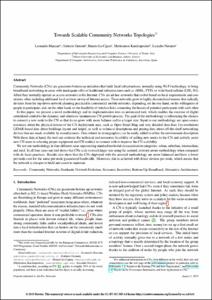Mostra el registre d'ítem simple
Towards scalable Community Networks topologies
| dc.contributor.author | Maccari, Leonardo |
| dc.contributor.author | Gemmi, Gabriele |
| dc.contributor.author | Lo Cigno, Renato |
| dc.contributor.author | Karaliopoulos, Merkourios |
| dc.contributor.author | Navarro Moldes, Leandro |
| dc.contributor.other | Universitat Politècnica de Catalunya. Departament d'Arquitectura de Computadors |
| dc.date.accessioned | 2019-10-01T08:51:42Z |
| dc.date.available | 2021-07-15T00:26:15Z |
| dc.date.issued | 2019-11 |
| dc.identifier.citation | Maccari, L. [et al.]. Towards scalable Community Networks topologies. "Ad hoc networks", Novembre 2019, vol. 94, núm. Article 101872, p. 1-14. |
| dc.identifier.issn | 1570-8705 |
| dc.identifier.other | http://dsg.ac.upc.edu/biblio?f%5Bauthor%5D=613 |
| dc.identifier.uri | http://hdl.handle.net/2117/168983 |
| dc.description.abstract | Community Networks (CNs) are grassroots bottom-up initiatives that build local infrastructures, normally using Wi-Fi technology, to bring broadband networking in areas with inadequate offer of traditional infrastructures such as ADSL, FTTx or wide-band cellular (LTE, 5G). Albeit they normally operate as access networks to the Internet, CNs are ad-hoc networks that evolve based on local requirements and constraints, often including additional local services on top of Internet access. These networks grow in highly decentralized manner that radically deviates from the top-down network planning practiced in commercial mobile networks, depending, on the one hand, on the willingness of people to participate, and, on the other hand, on the feasibility of wireless links connecting the houses of potential participants with each other. In this paper, we present a novel methodology and its implementation into an automated tool, which enables the exercise of (light) centralized control to the dynamic and otherwise spontaneous CN growth process. The goal of the methodology is influencing the choices to connect a new node to the CN so that it can grow with more balance and to a larger size. Input to our methodology are open source resources about the physical terrain of the CN deployment area, such as Open Street Map and very detailed (less than 1 m resolution) LIDAR-based data about buildings layout and height, as well as technical descriptions and pricing data about off-the-shelf networking devices that are made available by manufacturers. Data related to demographics can be easily added to refine the environment description. With these data at hand, the tool can estimate the technical and economic feasibility of adding new nodes to the CN and actively assist new CN users in selecting proper equipment and CN node(s) to connect with to improve the CN scalability. We test our methodology in four different areas representing standard territorial characterization categories: urban, suburban, intermediate, and rural. In all four cases our tool shows that CNs scale to much larger size using the assisted, network-aware methodology when compared with de facto practices. Results also show that the CNs deployed with the assisted methodology are more balanced and have a lower per-node cost for the same per-node guaranteed bandwidth. Moreover, this is achieved with fewer devices per node, which means that the network is cheaper to build and easier to maintain. |
| dc.format.extent | 14 p. |
| dc.language.iso | eng |
| dc.publisher | Elsevier |
| dc.rights | Attribution-NonCommercial-NoDerivatives 4.0 International |
| dc.rights.uri | https://creativecommons.org/licenses/by-nc-nd/4.0/ |
| dc.subject | Àrees temàtiques de la UPC::Enginyeria de la telecomunicació::Telemàtica i xarxes d'ordinadors::Xarxes de banda ampla |
| dc.subject.lcsh | Ad hoc networks (Computer networks) |
| dc.subject.lcsh | Electronic villages (Computer networks) |
| dc.subject.lcsh | Broadband communication systems |
| dc.subject.other | Community Networks |
| dc.subject.other | Stochastic network evolution |
| dc.subject.other | Economic incentives |
| dc.subject.other | Bottom-up broadband |
| dc.subject.other | Alternative architectures |
| dc.title | Towards scalable Community Networks topologies |
| dc.type | Article |
| dc.subject.lemac | Xarxes ad hoc (Xarxes d'ordinadors) |
| dc.subject.lemac | Ciutats digitals (Xarxes d'ordinadors) |
| dc.subject.lemac | Telecomunicació de banda ampla, Sistemes de |
| dc.contributor.group | Universitat Politècnica de Catalunya. CNDS - Xarxes de Computadors i Sistemes Distribuïts |
| dc.identifier.doi | 10.1016/j.adhoc.2019.101949 |
| dc.description.peerreviewed | Peer Reviewed |
| dc.relation.publisherversion | https://www.sciencedirect.com/science/article/abs/pii/S1570870518307480 |
| dc.rights.access | Open Access |
| local.identifier.drac | 25840783 |
| dc.description.version | Postprint (author's final draft) |
| dc.relation.projectid | info:eu-repo/grantAgreement/EC/H2020/688768/EU/network infrastructure as commons/netCommons |
| local.citation.author | Maccari, Leonardo; Gemmi, G.; Lo Cigno, R.; Karaliopoulos, M.; Navarro, L. |
| local.citation.publicationName | Ad hoc networks |
| local.citation.volume | 94 |
| local.citation.number | Article 101872 |
| local.citation.startingPage | 1 |
| local.citation.endingPage | 14 |
Fitxers d'aquest items
Aquest ítem apareix a les col·leccions següents
-
Articles de revista [1.049]
-
Articles de revista [107]


